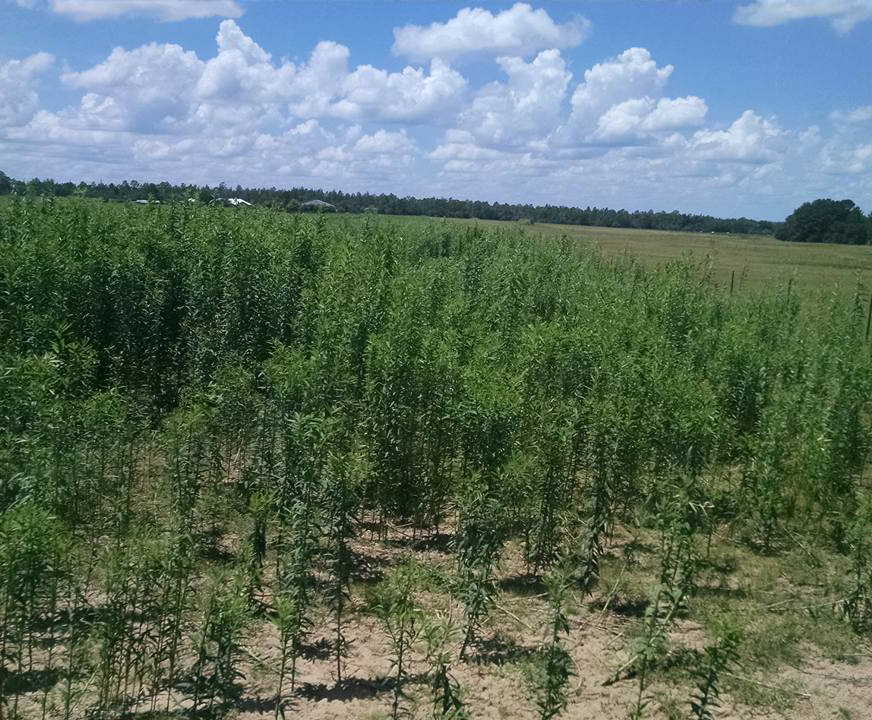
Sunn hemp is a fast growing, warm season, annual legume. It grows 6-7 feet tall. Sunn hemp can tolerate a wide range of soil pH (5.0-8.4). It is native to India and Pakistan. The University of Hawaii and USDA NRCS, together, released the variety called “Tropic Sun” in 1982. This variety only makes seed during periods of short day length and a certain range of temperatures. These factors limited seed production. Recently, however, Auburn University released AU Golden and AU Darbin varieties that are able to produce seeds in more temperate climates. Since sunn hemp is a legume, it fixes more than 120lbs of nitrogen from the environment per acre, per season. It can yield 3,000 to 10,000lbs of forage per acre. It can be grown in a wide range of soil types, but is most productive in more fertile soils. Sunn hemp has traditionally been utilized as a cover crop, but has recently been evaluated as a forage for livestock as well for wildlife food plots.
The advantages of using sunn hemp as a cover crop are the large amount of biomass produced per acre, nitrogen fixation, nematode suppression, and weed suppression. Because it can grow in a wide range of soil types and pH levels, and because of its drought tolerance, hunters have tried it for wildlife food plots. Research has shown that Sunn Hemp is an acquired taste, and that livestock and wildlife need time to become accustomed to it, but the nutrient quality of the leaves is very high with crude protein (CP) ranging from 25-30%.
Sunn hemp is an interesting option for livestock warm season annual grazing. Plant sunn hemp once soil temperatures have reached 65°F. Use a seeding rate of 25-30lb per acre and planting depth of 1/4” to 1”. Don’t forget the cowpea type inoculant. Because this is a legume crop that fixes its own nitrogen (N), N fertilization is not required. Soil test for pH, phosphorus and potassium prior to planting, and apply the recommended nutrients based on the soil test results.
Grazing management is very important for Sunn Hemp. The goal is to keep the plants in a vegetative growth stage with a high percentage of leaves compared to stalks. The leaves are 25-30% CP with TDN of 65-71%. The stems are much lower quality (8-10% CP and 22% TDN). Grazing and forage management should focus on maximizing leaf-to-stem ratio. Start grazing approximately 45 days after planting when the sunn hemp reaches 1.5-3 feet tall. If you wait too long, sunn hemp can reach a height of over 6′ and livestock will break off the plants and prevent regrowth. Stop grazing when stubble is 12-18″ to allow regrowth. Overgrazing or mowing below 12″ can kill the plant and prevent regrowth. Because of its high quality, sunn hemp works well using limit grazing (1-3 hours/day) to compliment traditional perennial pastures.
Sunn Hemp is an annual legume that is not related to industrial hemp or marijuana. It is actually in the Crotalaria family, but unlike other species in this plant family that are toxic, sunn hemp contains much lower levels of alkaloid compounds. Sunn hemp seeds do contain small amounts of toxic alkaloids, so seeds should not be fed in livestock diets. Small amounts of seeds consumed while grazing are not enough to cause acute toxicity. The leaves and stems are not toxic to livestock.
For more information on using sunn hemp as a forage, use the following link to a recently published Alabama Extension fact sheet: Grazing Sunn Hemp
 0
0
